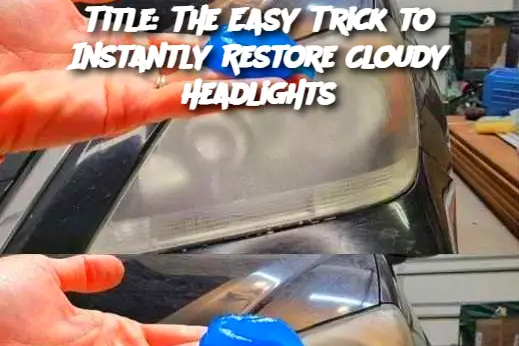-
Mix the Solution:
-
Combine 2 tablespoons of baking soda with 1/4 cup of white vinegar in a small bowl. It will fizz at first—let it settle before proceeding.
-
-
Spray the Headlights:
-
Lightly spray your headlights with clean water to remove surface dust and dirt. Wipe them down with a microfiber cloth to ensure they’re ready for the treatment.
-
-
Apply the Paste:
-
Use a soft sponge or cloth to spread the baking soda and vinegar mixture onto the headlights. Work it in using small circular motions, making sure to cover the entire surface.
-
-
Wait a Few Seconds:
-
Allow the mixture to sit on the headlights for about 30 seconds to one minute. This gives it time to break down the buildup and loosen the grime.
-
-
Buff and Rinse:
-
After waiting, gently buff the headlights with a clean, dry cloth. Then rinse with clean water and dry them thoroughly with another microfiber cloth.
-
Serving and Storage Tips (How to Maintain the Results):
-
Reapply as Needed: If the headlights become cloudy again over time, repeat this process as needed.
-
Protect with Wax: After cleaning, consider applying a layer of car wax or a UV-protective coating to maintain clarity and prevent future yellowing.
-
Regular Cleaning: Wipe down your headlights with a damp cloth every few weeks to remove surface dirt and grime.
-
Store the Ingredients: Keep a small container of baking soda and vinegar in your garage so you’re ready for quick touch-ups whenever needed.
Variants (Alternative Methods to Try):
-
Toothpaste Method:
-
Instead of baking soda and vinegar, apply a small amount of toothpaste (non-gel) to the headlights. Spread it with a damp cloth, let it sit for a minute, and then buff it away for clearer lights.
-
-
Baking Soda and Water Paste:
-
If you prefer to skip vinegar, mix baking soda with a small amount of water to create a paste. This gentle abrasive can still help clear cloudy headlights.
-
-
DIY Headlight Restoration Kits:
-
For more stubborn cases, consider using a store-bought headlight restoration kit. These often include a mild abrasive, polish, and a UV-protectant to help maintain clarity.
-
FAQ:
Q: Will this method damage my headlights?
A: No, the gentle combination of baking soda and vinegar is safe for most plastic headlight lenses. Always test a small area first if you’re unsure.
Q: How often should I clean my headlights?
A: Clean them as soon as you notice cloudiness or yellowing. Regular maintenance every few months helps keep them clear and bright.
Q: Can I use this method on glass headlights?
A: Most modern headlights are made from plastic or polycarbonate. If your car has glass headlights, check the manufacturer’s recommendations before applying any abrasive cleaner.
Q: Will this completely fix heavily damaged headlights?
A: For heavily oxidized or scratched headlights, this method may improve clarity but won’t restore them to like-new condition. In those cases, you may need a professional restoration or replacement.
Q: Do I need any special equipment to apply this treatment?
A: No, all you need are common household items like baking soda, vinegar, and a cloth. No specialized tools are required
